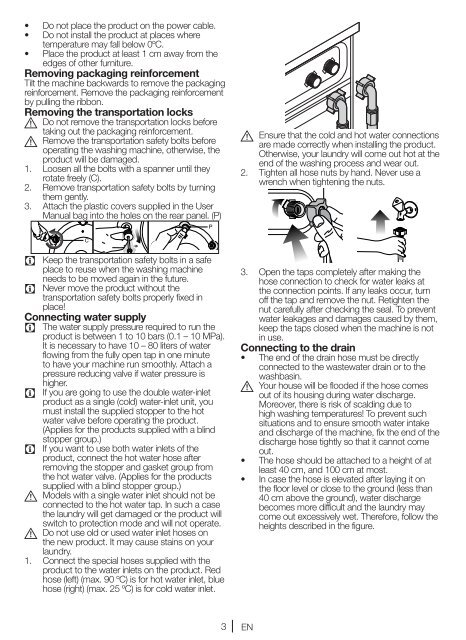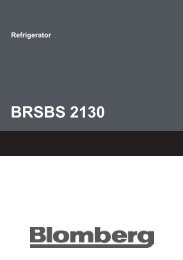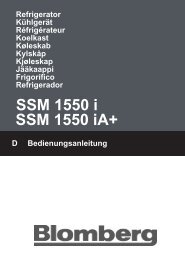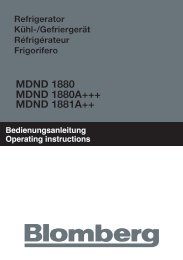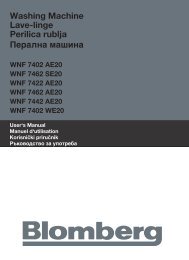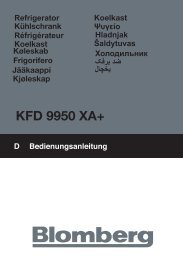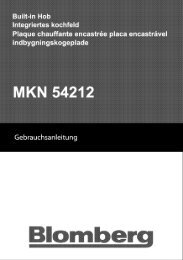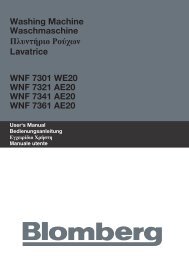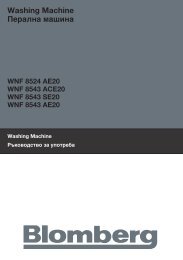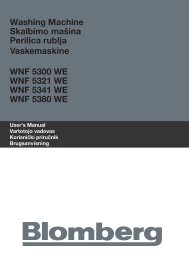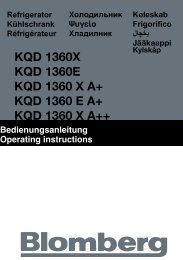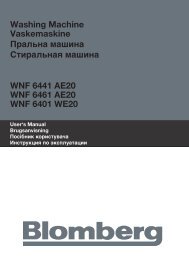Washing Machine Vaskemaskine Πλυντήριο Ρούχων ... - Blomberg
Washing Machine Vaskemaskine Πλυντήριο Ρούχων ... - Blomberg
Washing Machine Vaskemaskine Πλυντήριο Ρούχων ... - Blomberg
You also want an ePaper? Increase the reach of your titles
YUMPU automatically turns print PDFs into web optimized ePapers that Google loves.
• Do not place the product on the power cable.<br />
• Do not install the product at places where<br />
temperature may fall below 0ºC.<br />
• Place the product at least 1 cm away from the<br />
edges of other furniture.<br />
Removing packaging reinforcement<br />
Tilt the machine backwards to remove the packaging<br />
reinforcement. Remove the packaging reinforcement<br />
by pulling the ribbon.<br />
Removing the transportation locks<br />
Do not remove the transportation locks before<br />
A<br />
A<br />
taking out the packaging reinforcement.<br />
Remove the transportation safety bolts before<br />
operating the washing machine, otherwise, the<br />
product will be damaged.<br />
1. Loosen all the bolts with a spanner until they<br />
rotate freely (C).<br />
2. Remove transportation safety bolts by turning<br />
them gently.<br />
3. Attach the plastic covers supplied in the User<br />
Manual bag into the holes on the rear panel. (P)<br />
C<br />
C<br />
Keep the transportation safety bolts in a safe<br />
place to reuse when the washing machine<br />
needs to be moved again in the future.<br />
Never move the product without the<br />
transportation safety bolts properly fixed in<br />
place!<br />
Connecting water supply<br />
C<br />
C<br />
C<br />
A<br />
A<br />
The water supply pressure required to run the<br />
product is between 1 to 10 bars (0.1 – 10 MPa).<br />
It is necessary to have 10 – 80 liters of water<br />
flowing from the fully open tap in one minute<br />
to have your machine run smoothly. Attach a<br />
pressure reducing valve if water pressure is<br />
higher.<br />
If you are going to use the double water-inlet<br />
product as a single (cold) water-inlet unit, you<br />
must install the supplied stopper to the hot<br />
water valve before operating the product.<br />
(Applies for the products supplied with a blind<br />
stopper group.)<br />
If you want to use both water inlets of the<br />
product, connect the hot water hose after<br />
removing the stopper and gasket group from<br />
the hot water valve. (Applies for the products<br />
supplied with a blind stopper group.)<br />
Models with a single water inlet should not be<br />
connected to the hot water tap. In such a case<br />
the laundry will get damaged or the product will<br />
switch to protection mode and will not operate.<br />
Do not use old or used water inlet hoses on<br />
the new product. It may cause stains on your<br />
laundry.<br />
1. Connect the special hoses supplied with the<br />
product to the water inlets on the product. Red<br />
hose (left) (max. 90 ºC) is for hot water inlet, blue<br />
hose (right) (max. 25 ºC) is for cold water inlet.<br />
A<br />
3 EN<br />
Ensure that the cold and hot water connections<br />
are made correctly when installing the product.<br />
Otherwise, your laundry will come out hot at the<br />
end of the washing process and wear out.<br />
2. Tighten all hose nuts by hand. Never use a<br />
wrench when tightening the nuts.<br />
3. Open the taps completely after making the<br />
hose connection to check for water leaks at<br />
the connection points. If any leaks occur, turn<br />
off the tap and remove the nut. Retighten the<br />
nut carefully after checking the seal. To prevent<br />
water leakages and damages caused by them,<br />
keep the taps closed when the machine is not<br />
in use.<br />
Connecting to the drain<br />
• The end of the drain hose must be directly<br />
connected to the wastewater drain or to the<br />
A<br />
washbasin.<br />
Your house will be flooded if the hose comes<br />
out of its housing during water discharge.<br />
Moreover, there is risk of scalding due to<br />
high washing temperatures! To prevent such<br />
situations and to ensure smooth water intake<br />
and discharge of the machine, fix the end of the<br />
discharge hose tightly so that it cannot come<br />
out.<br />
• The hose should be attached to a height of at<br />
least 40 cm, and 100 cm at most.<br />
• In case the hose is elevated after laying it on<br />
the floor level or close to the ground (less than<br />
40 cm above the ground), water discharge<br />
becomes more difficult and the laundry may<br />
come out excessively wet. Therefore, follow the<br />
heights described in the figure.


